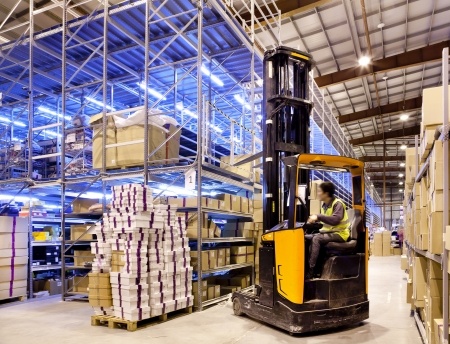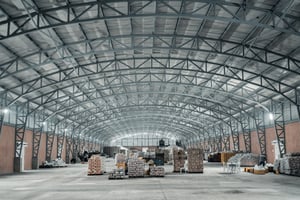Warehouse temperature control can be a major headache for any warehouse manager. It can also be...
How to Decrease Warehouse Energy Costs
Warehouses are a vital part of many businesses, providing a space to store and distribute goods. However, operating a warehouse can be expensive, especially when it comes to energy costs. In this blog post, we'll explore some ways you can decrease energy costs in your warehouse.

Here are 6 actionable ways you can help effectively decrease warehouse energy costs.
- Energy-Efficient Lighting
- Efficient Heating and Cooling Systems
- HVLS Fans
- Proper Insulation
- Energy Efficient Equipment
- Energy Usage Monitoring
1 - Energy Efficient Lighting
One of the easiest ways to reduce energy costs is to implement energy-efficient lighting. Traditional incandescent bulbs are inefficient and can be expensive to run. Instead, consider switching to LED lighting, which uses 75% less energy than incandescent bulbs and can last up to 25 times longer. This can mean major savings on your energy bills.
Energy-efficient lighting in a warehouse can help reduce electricity costs and improve the overall energy efficiency of the building. One way to achieve this is by using LED lights, which are more energy efficient than traditional incandescent or fluorescent lights. LED lights also have a longer lifespan, which means they need to be replaced less often, further reducing maintenance costs. Additionally, using sensors and controls to manage the lighting in a warehouse can help reduce energy usage by ensuring that lights are only on when they are needed. This can be especially effective in areas of the warehouse that are not in use all the time, such as storage areas or offices. Overall, implementing energy-efficient lighting in a warehouse can not only help save money on energy costs but also improve the sustainability of the building.
2 - Efficient Heating and Cooling Systems
Another way to reduce energy costs is to invest in efficient heating and cooling systems. Heating and cooling can account for a significant portion of a warehouse's energy costs, so it's important to make sure these systems are running efficiently. Consider upgrading to energy-efficient HVAC systems and making sure they are properly maintained to ensure they are running at peak efficiency.
Furthermore, pairing your HVAC system with high volume, low speed (HVLS) ceiling fans can further reduce your energy costs. The huge fans will push the cool air down and out around the warehouse, equally distributing the air. This creates a cooling effect leaving employees feeling cooler while working.
3 - HVLS Fans
High volume, low speed (HVLS) fans are a type of industrial ceiling fan that is designed to move a large amount of air at a slow speed. They can be an effective way to decrease energy costs in a warehouse or other large space because they can help to reduce the need for heating and cooling. In addition, they are a relatively small upfront cost for the quick return on investment. Fans actually run for as little as $0.37 per day!
HVLS warehouse fans work perfectly in environments with or without HVAC units. Fans create a gentle breeze that circulates the air evenly in a space. They help to even out the temperature, reducing hot and cold spots. As a result, HVLS fans can make a space more comfortable for employees and customers, which can increase productivity and satisfaction.
In addition, because HVLS fans create a gentle breeze, they can help to evaporate moisture from the air. This can reduce the relative humidity in a space, which can make it feel cooler. As a result, HVLS fans can reduce the need for air conditioning, which can save energy and money.
Because HVLS fans move a large volume of air at a slow speed, they use less energy than traditional fans, which move a smaller amount of air at a faster speed. This means that using HVLS fans can help to reduce your energy bills and save money.
4 - Proper Insulation
Insulating your warehouse can also help reduce energy costs. Proper insulation can keep heat in during the winter and out during the summer, reducing the need for heating and cooling. This can result in significant savings on your energy bills and make your warehouse more comfortable for employees.
5 - Energy-Efficient Equipment
Another way to reduce energy costs is to use energy-efficient equipment. Many warehouses use forklifts and other equipment that can be expensive to run. Consider upgrading to electric or hybrid forklifts, which use less energy and produce fewer emissions than traditional gas-powered models. This can result in significant savings on your energy bills and help reduce your carbon footprint.
6 - Energy Usage Monitoring
Finally, consider implementing a program to monitor and manage energy use in your warehouse. By tracking your energy usage and implementing strategies to reduce it, you can identify areas where you can save money and make your warehouse more energy-efficient.
As you can see, there are many ways to reduce energy costs in your warehouse. By implementing energy-efficient lighting, heating and cooling systems, HVLS fans, insulation, and equipment, and monitoring and managing your energy use, you can save money and make your warehouse more sustainable.
About MacroAir
MacroAir invented the High Volume, Low Speed (HVLS) industrial ceiling fan, and we continue to be a leader in the market by developing the most innovative large fans in the world. We continually strive to push boundaries and set the bar when it comes to engineering and product development. Our end goal is always with you at the center - improving your quality of life.
We understand that working in a warehouse can be challenging. MacroAir fans can help make it more comfortable. If fact, adding an industrial ceiling fan can make you feel up to 15° cooler.
MacroAir technology is based on the principle that moving air slowly is far more efficient than moving air quickly. Our HVLS fans move air down and out in all directions, keeping the air fresh and helping people and animals feel more comfortable. Comparatively, MacroAir products are unparalleled in energy efficiency and airflow. Fans are assembled in the USA and installed worldwide.
If you would like to learn more about MacroAir Fans, check out the MacroAir Effect. Simply click the link to see the benefits offered.
.jpg?width=455&height=304&name=Industrial_Warehouse_Lift_Truck_Center_Springfield_MO_MacroAir_AVD780_20ft_Powdercoated_Red_6%20(1).jpg)

